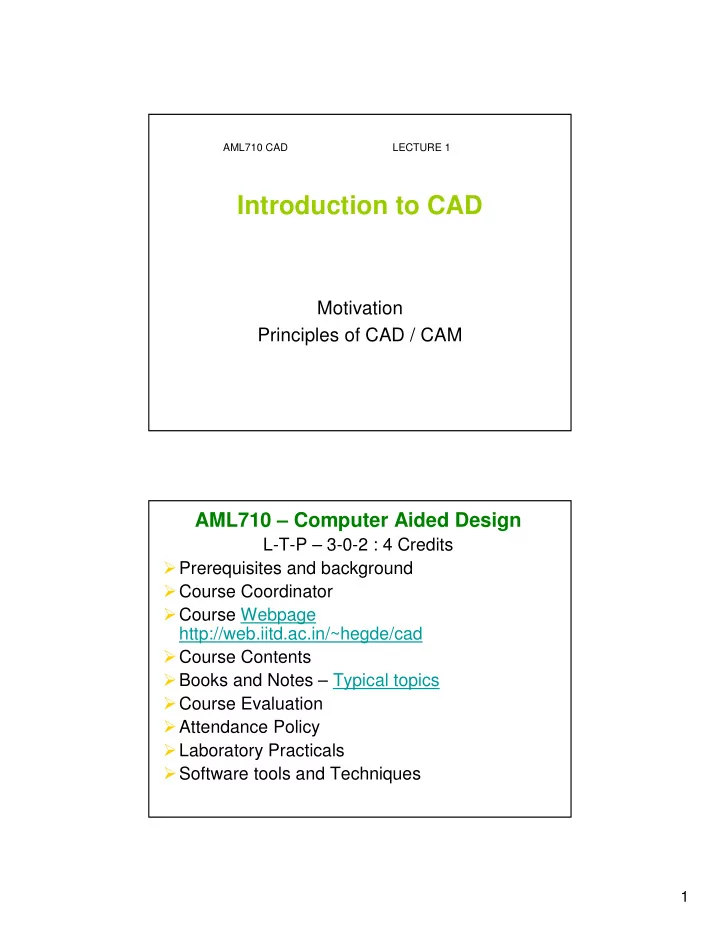

AML710 CAD LECTURE 1 Introduction to CAD Motivation Principles of CAD / CAM AML710 – Computer Aided Design L-T-P – 3-0-2 : 4 Credits � Prerequisites and background � Course Coordinator � Course Webpage http://web.iitd.ac.in/~hegde/cad � Course Contents � Books and Notes – Typical topics � Course Evaluation � Attendance Policy � Laboratory Practicals � Software tools and Techniques 1
Motivation for the Study of CAD Application of CAD/CAM • Aerospace Motivation for the Study of CAD Application of CAD/CAM • Aerospace • Automotive • Chemical & Process • Communications • Computers & IT • Electrical & Electronics Examples • Medical & Pharma • Military & Defence • Rail & Marine • Structural & Civil • Apparel and Textile 2
Graphics Pipeline Real world Object Modeling Rendering/ Viewing Transformations Shading Transformations Geometrical Model Visual Realism Orthographic/ Perspective Clipping Display Rasterization PROJECTION Projections Graphics Pipeline Theme of the Course • Starting from geometric concepts we proceed to compute something in several steps as: Geometry -> Algebra -> Algorithm -> Program Ex: Circle -> implicit/parametric equation->Smith’s algorithm->computer implementation in C/C++/MATLAB (OpenGL) x 2 + y 2 = 1 x = cos( t ) y = sin( t ) 3
The Geometric Complexity • As algorithms are an integral part of the geometry -> Program representations, we need to think of the complexity involved. They are: 1. Dimensional Complexity- 1D/2D/3D 2 . Analytic Complexity- Polynomials of degree 1,2,3,…. 3. Combinatorial Complexity- For example, searching a sorted array of n elements uses O(log2n) comparisons. • 4. Continuum to Discrete • 5. Precision and Errors What is Design? ���������������������������������������������� �������������������������������������� ������������������������������������ ���������������������������������� • Design, usually considered in the context of applied arts, engineering, architecture, and other creative endeavors, is used both as a noun and a verb. • As a verb, "to design" refers to the process of originating and developing a plan for a product, structure, system, or component. • As a noun, "a design" is used for both the final (solution) plan (e.g. proposal, drawing, model, description) or the result of implementing that plan (e.g. object produced, result of the process). More recently, processes (in general) have also been treated as products of design, giving new meaning to the term "process design” 4
Some Popular Design Approaches • User-centered design, which focuses on the needs, wants, and limitations of the end user of the designed artifact. • Use-centered design, which focuses on the goals and tasks associated with the use of the artifact, rather than focusing on the end user. • KISS principle, (Keep it Simple, Stupid), which strives to eliminate unnecessary complications • There is more than one way to do it (TMTOWTDI), a philosophy to allow multiple methods of doing the same thing • Murphy's Law (things will go wrong in any given situation, if you give them a chance) What is Design? Design is an Iterative Process (Ohsuga 1989) Build Model Requirement Model 1 Analyse / Evaluate Modify / Refine Model 2 Modify / Refine Analyse / Evaluate Generate information for planning and Model n CAPP manufacture NC / CNC PRODUCT 5
The Design Process – An Engineering Activity 1. Need 2. Concept 3. Modeling and Simulation 4. Analysis – FEM (Geometrical Data) 5. Optimize – Shape / Structure / Topology 6. Evaluate – testing / Inspection / Comparison 7. Communicate – prepare drawings and details Taking assistance of Computers in Design 1. Manual Design 2. Geometric Models and Graphics 3. Move / Animate / Visualise 4. Use Analysis tools and software 5. Optimize – Maximize / minimize the objective functions: Structure, Shape, Topology 6. Evaluate – test and check the model 7. Communicate – Drafting and detailing Generate information Manage/Control Communicate 6
Definition of CAD Computer aided Design is a subprocess of Design process Computer Network Graphics CAM CAD CAD Manufacturing Geometric Design Modeling Engineering Computer Aided Design 1. CAD Technology = Design Techniques + Computers (HW+SW) 2. The CAD Process is the subset of the Design process 3. The CAM Process is a subset of Manufacturing Process 4. Integration of CAD and CAM leads to automation 7
Steps in CAM activity Geometric Model Interfacing CAPP NC Programs Inspection Assembly Packaging Graphics Standards Many Graphics Standards have been in use. The real issue with choosing the standards is portability and device independence. • BGI • GKS • PHIGS • OpenGL A ray tracing Example 8
Recommend
More recommend